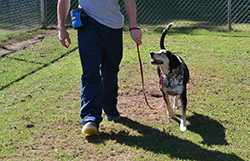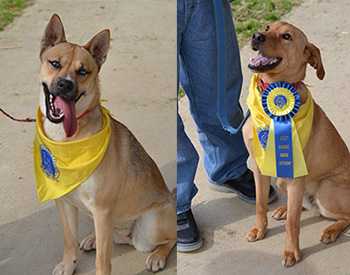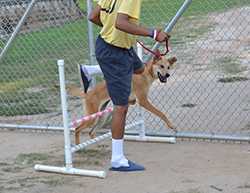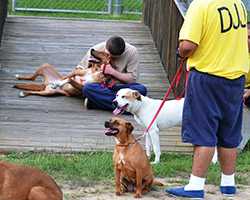Dogs and Boys Build Character Together

A boy trains a dog named Dalton at a juvenile detention center in Georgia. (Photo courtesy of Rescue 2 Restore)
The best part of the day for a group of boys in a juvenile detention center in Midland, Georgia, is playing with dogs. The boys are responsible for taking care of and training several dogs, and the animals repay them by providing a sense of purpose and unconditional love.
Georgia Department of Juvenile Justice’s Rescue 2 Restore program began in 2014 with the intent to improve the quality of life for youths housed in Georgia juvenile detention centers and provide a second chance at adoption for homeless dogs that otherwise might have been euthanized.
Training Dogs to Be Good Pets
During the first year of the program, approximately 30 youths at detention centers in Georgia participated in Rescue 2 Restore, acting as full-time caregivers for the dogs by feeding, cleaning, walking, and training them.

Shadow, left, and Nanook, right, earned Canine Good Citizen certificates, thanks to help from their teenage trainers in the Rescue 2 Restore program. (Photos courtesy of Rescue 2 Restore)
The routine is rigorous. The boys at the juvenile detention centers start their days by walking and feeding their dogs at 5 a.m., using their lunch break to check on the dogs. They provide basic obedience training for about an hour after school and do the last check of the day around 7 p.m. to make sure their pups have water and are clean, fed, and walked. The boys help the dogs earn their Canine Good Citizen certificates before returning to the local Humane Society to await adoption, a routine lasting 12 weeks. “A well-behaved dog is a safer dog. It gets adopted quickly,” explains Chrissy Kaczynski, Rescue 2 Restore program coordinator.
Proud of their canine friends, the boys enjoy showing off their progress. On a bright afternoon in Midland, Tommy, age 17, puts his buddy Ralph—a yellow Labrador retriever mix who won the most-improved award in his training class—on a leash to practice tricks. Thanks to Tommy, this energetic pup relaxed and went from being the worst walking on a leash to the best in just one week.
Rescue 2 Restore dogs learn the basic commands of sit, down, stay, come, and heel, as well as special ones like fetch, roll over, and shake paws/hands. In addition, the program helps the youths. “If we don’t have friends, the dog can be our best friend,” declares Jay, also age 17.
“I can relate to animals better than I can relate to people,” adds Tommy, whose work with the dogs has changed his life. He admits he used to have anger-management problems; his behavior often landed him in trouble. But the chance to be part of the program was an incentive that inspired him to change. To participate, he had to change his behavior, which he was able to do thanks to individual and group counseling.
Positive Reinforcement Works

Ralph won most-improved in his training class. (Photo courtesy of Rescue 2 Restore)
Tommy learned how to train the dogs gently with positive reinforcement by using treats to reward positive behavior (for example, when the dogs obeyed commands like “sit” and “stay”); negative behavior was ignored.
“Positive rewards and patience yield positive results,” says Kaczynski. “We don’t endorse negative reinforcement. Even if the kids get frustrated, they don’t take it out on the dogs.” Participating in Rescue 2 Restore is a privilege. To qualify, youths must remain on good behavior and do well in school. Behavioral health professionals help select boys to make sure they are the right fit for the program.
The benefits are well worth the effort, according to Tommy. Dogs like Pansy, a border-collie mix, and Joy, an Akita mix, have provided comfort, companionship, love, and fun. Tommy has learned discipline and other character traits that have helped him calm down, focus on his studies, and even pass the General Educational Development (GED) high-school equivalency test. “Without the dogs, I never would have gotten my GED,” Tommy says. “They taught me patience. I was able to apply that patience to studying.”
Animals Provide Health and Social Benefits

Rescue 2 Restore is a win-win for the boys and their dogs, as both benefit from exercise, unconditional love, and new skills. (Photo courtesy of Rescue 2 Restore)
With the Rescue 2 Restore program, everybody wins. While the youths are helping to transform the lives of these dogs, the animals are helping the boys be happier, more productive members of society. Thanks to the human-animal bond, the boys have less depression and build many valuable skills. Once the youths are back in society, they can apply these skills when interacting with their families, coworkers, and community members, according to Kaczynski. “They’re much more appropriate and polite. They become role models for other youths in the facility,” she says.
In addition to gaining responsibility and compassion, some of the boys in Midland, Georgia, have learned teamwork and leadership skills. Sometimes, the dogs help youths overcome shyness and learn to interact with human peers. For instance, says Chris, age 15, “When I was on the outside, I didn’t build bonds. This is teaching me how.”
Tommy agrees: “I worked with Pansy for several weeks. She had been shy. I put her on a leash and started working with her to get her out of her comfort zone. I couldn’t have gotten her over her shyness without everyone else’s help. If we see someone struggling on the team, we help them train their dog.”
In addition to teaching the boys how to safely handle and train the dogs, community volunteers educate the youths on a variety of animal topics, including dog behavior, body language, animal abuse and cruelty, rescue, and adoption from animal shelters. They discuss proper animal care, such as a good diet, plenty of exercise and play, regular veterinary check-ups and vaccines, and the benefits of spaying and neutering to reduce the number of animals in shelters.
I Think about My Dog First

Youths at a juvenile detention center in Georgia help save homeless pets. (Photo courtesy of Rescue 2 Restore)
The education and animal-assisted activities already have helped many at-risk youths and the dogs they love. The Rescue 2 Restore program offers something to look forward to each day. As Ron, age 18, says, “When I wake up in the morning, the first thing I think about is my dog. I can’t wait to see him and feed and walk him.”
When he thinks about the training being over and saying goodbye to Ralph, Tommy has a sad look on his face. But he knows a new furry friend will show up soon, needing care, love, and training.
“They know they’ve accomplished something. We ask the Humane Society and adopters to update the boys about their dogs. We tell them when their dogs get adopted and what we know about the families; they feel like they’re saving homeless pets,” says Kaczynski. “They’re sad to see the old dogs leave, but when the new dogs arrive, they’re excited, so it balances out.”
(* Names have been changed to protect the privacy of boys in Rescue 2 Restore programs.)
For More Information
- Dogs /Healthy Pets Healthy People, Centers for Disease Control and Prevention
- Preventing Dog Bites, Centers for Disease Control and Prevention
- Rabies, Centers for Disease Control and Prevention
- Ticks, Centers for Disease Control and Prevention
- American Society for the Prevention of Cruelty to Animals
- Canine Good Citizen program, American Kennel Club
- Rescue 2 Restore, Georgia Department of Juvenile Justice
- Why Spay/Neuter? Humane Society of the United States
- Page last reviewed: November 24, 2015
- Page last updated: November 24, 2015
- Content source:


 ShareCompartir
ShareCompartir